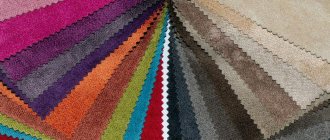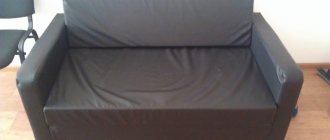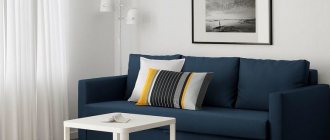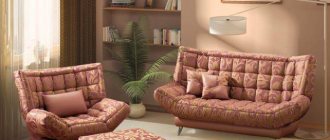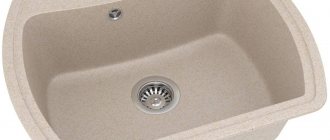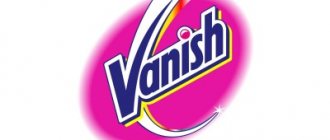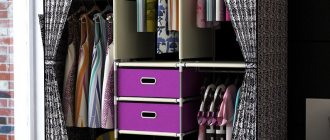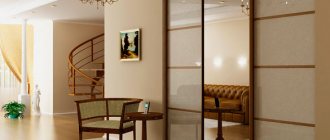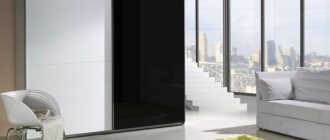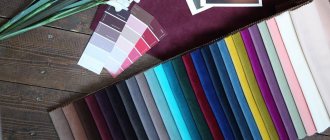Artificial suede is a modern material that is widely used in furniture production. This material has many advantages, but it also has its disadvantages. Artificial suede is practically indistinguishable from natural leather in appearance, therefore it can give a stylish, noble and “expensive” look to furniture.
One of the main disadvantages includes some difficulties in caring for furniture with this upholstery. However, first things first. In this article, let's look at all the pros and cons of artificial suede as an option for furniture upholstery, and find out what people who have already acquired such furniture say.
What is the difference between artificial suede and natural one?
To learn how to distinguish artificial fabric from natural fabric, you should have an idea about them, as well as know what material options exist. Natural suede is leather that has been treated with fats. The fake material is made from fabric with suede pile, impregnated with glue.
Artificial suede is practically indistinguishable from natural leather in appearance.
A high-quality natural product has a soft, pleasant-to-touch pile. It has a high cost. This is due to the high costs of its production. Natural material can be determined by a number of criteria:
- porous structure;
- trace from stroking the fabric;
- soft touch;
- specific smell;
- there is no fabric on the reverse side;
- high price;
- quickly absorbs moisture.
This upholstery can give a stylish, noble and “expensive” look to furniture.
Being able to identify the differences between natural and artificial materials will help you save money. When buying furniture, focusing only on cost is not logical. An unscrupulous seller can pass off synthetic textiles as natural, and this will significantly increase the cost of the product as a whole. The artificial material is homogeneous in structure and smooth.
Many manufacturers call this material “new generation technology.”
On the reverse side of the product there is fabric. Touching the material does not leave a dark finger or hand mark. The smell is synthetic and pungent. Another simple way to distinguish a non-natural surface is water. Synthetic suede practically does not absorb moisture. All the characteristics inherent in a suede substitute will allow you not to overpay several times for a piece of furniture.
Peculiarities
Faux suede has a very simple fiber composition. One quarter is cotton and the rest is polyester. The fibers are combined with a fabric fabric; sometimes the finished product is treated with a layer of Teflon on top, so that the material does not absorb liquid contaminants. The rigidity and flexibility of the product is determined by the structure of the threads. Synthetic fibers provide a high degree of elastic elongation; the fabric is minimally susceptible to creasing and does not stretch throughout the entire period of use. There are two types of faux suede:
- on a fabric basis;
- on a continuous non-woven basis.
The first option is more popular, as it allows air to pass through well. The differences lie in the structure of the material; the height, density and direction of the pile differ. The nobility of suede is formed from the play of light shades. Everyone knows the effect that is created on fabric when stroking it with your hand. The higher the pile, the brighter the remaining mark.
Particular attention in production is paid to painting the product. This process consists of three stages - adsorption, diffusion and fixation of dyes
Before paint is applied to the canvas, it is carefully examined for defects, and heat and steam treatment is carried out. Acid, chrome, direct, and disperse dyes are used for coloring.
Furniture stores now offer a wide variety of faux suede colors. Typically, buyers prefer to choose a solid color option, but suede with a pattern is also quite common.
Characteristics of artificial suede
The demand for artificial materials is driven by the struggle to increase the number of animals. Initially, the natural material was made from chamois leather. Later, the skin of deer, goats, sheep, and antelopes began to be used for production. But since the resulting material is expensive and its wear resistance is average, we began to think about how to reduce costs.
Faux suede is a unique combination of polyester and natural cotton.
A cheaper analogue was launched into production, which in turn became popular due to its wear resistance and high technical characteristics. Upon visual assessment, the material is no different from artificial. And in some features they even surpass it.
What is it made of, fabric composition
An analogue of natural suede has a simple composition, including:
- cotton;
- polyester;
- glue.
The material is perfect for upholstering any upholstered furniture.
The glue used is PVA based. After making the fabric, it is coated with Teflon. This provides protection from moisture and dirt. Processing provides additional opportunities - suede can be washed. The use of detergents does not affect the properties of the fabric. The only thing you should do after washing is tidy up the pile.
Take care of suede furniture.
A sofa made of artificial suede should be brushed after drying. If the fabric feels hard to the touch, this indicates that it has been laminated or glued. This procedure is performed in order to rid the material of bubbling. It also eliminates stretching of textiles and the formation of folds.
Use a vacuum cleaner to clean the sofa.
Reviews
Let's see what those who have already purchased and are using upholstered furniture with faux suede upholstery write.
- Ivan, 54 years old, Tambov: “I chose the furniture together with my wife. We wanted one that would last a long time, so that we wouldn’t have to buy another one, since we’re about to retire. Out of habit, we wanted to choose textile upholstery, but we were advised to use artificial suede, they said that it was much more durable. We quickly picked out the furniture on the same day and chose the color to match the room. Now we have been using it for 3 years. No complaints. In my opinion, she hasn’t even lost her color. Easy care. The sofas and armchairs are very soft and a pleasure to use. I think we made the right choice. I advise."
- Irina, 37 years old, Samara: “We bought a new apartment and decided to furnish it only with new furniture. Everything was purchased to order. We spent a long time thinking about upholstering upholstered furniture, but in the end we settled on faux suede. My friend has this upholstery and she is very happy. And now I'm happy too. The furniture looks chic, is very pleasant to touch, and does not fade. It doesn't even leave stains on it because it has a special Teflon treatment. I am pleased. I recommend".
What is faux suede called?
Non-natural suede is also called eco-suede. This is not quite the correct name, but manufacturers often use these words as synonyms. All eco-suede is an artificial material. But not everything artificial is eco-friendly. It is understood that if materials that do not harm the environment were used to produce the fabric, then the material is eco-friendly.
This type of material is much easier to care for than its woven counterpart.
All other products are correctly called non-natural suede elements. The material used for upholstery can also be called Alcantara. Some manufacturers may present this as a new product among upholstery products. But in essence, this is ordinary synthetic suede. Therefore, you should pay attention not to the name of the material, but to the method of its manufacture, type.
Types of material
Among the types of manufacturing, 2 types of varieties can be distinguished:
- woven;
- non-woven
The woven material is very tear-resistant anywhere in upholstered furniture.
Both types look no worse than similar non-synthetic material. A piece of furniture such as a suede sofa requires attention and proper care. In the case of artificial upholstery, everything is simpler.
Woven method
This type is not very practical for upholstery. More often, such textiles are used for the production and design of clothing and shoes. Covers are made from it for sofas and armchairs, which perfectly cope with the functions assigned to them. The principle of production of woven covering is splitting microfiber threads.
The sofa upholstery does not stretch or deform during use.
At first, the appearance of the product looks respectable, but it quickly loses its properties. The quality of the woven product can be improved by increasing the microfiber processing time. During the work process, the fibers turn out to be of different lengths. The longer the manufacturer carries out the operation, the higher the quality of the suede obtained.
Non-woven method
Non-woven material is obtained by applying an adhesive composition to a specially prepared surface. After applying the layer, the fiber is sprayed. If Teflon is added at the same time, the resulting material is much stronger.
Suede for fabric-based furniture is more valued.
For the base, synthetics and knitwear are used. It must be primed so that the glue can be applied in an even layer. The Teflon coating can also be applied after the pile has been sprayed. But this must be done without fail, since this is the main way to protect the coating from moisture and dirt.
Varieties
The softness, smoothness, and strength of a material depend not only on the raw material composition. An important indicator that determines its appearance, mechanical, physical, and technological properties is the weave of the threads. The type of weave for suede fabric is determined by the direction of the longitudinal and transverse threads, which, according to the classification of the weave, are: simple, complex, finely patterned, large patterned.
Fabric base
The basis of artificial suede is most often the ratio of synthetic and natural fibers from cotton and knitwear. In the production of fabrics of heterogeneous fibrous composition, both simple and complex types of weaves are used. For faux suede, a satin weave of weft and warp is ideal. The fabric is obtained with a smooth surface, good elasticity, stretchability, drape, and is characterized by increased strength and durability. The number of threads, their length, width, and the sequence of weft and warp weaves have a great influence on the density of the fabric.
The processing of the top face layer of the material takes a lot of time. Alternating warp, weft, and pile threads form a durable fabric, onto which PVA glue is applied, then a polyester or polyamide coating is glued, ideally imitating the texture of natural pile.
During the weaving process, any fiber is subjected to repeated bending, tension, and friction. To ensure that the base of the fabric does not lose its elasticity, resilience, and durability, high-quality chemical fiber is used.
Other basis
The technology for producing material using a non-woven method has its own distinctive features from a woven base. Artificial fabric for furniture is made from homogeneous fibers, the simplest type of weave. To obtain pile, the fibers of the fabric are processed on a special brushing machine “Brashing. The threads, splitting well into fibers of varying thickness and height, form an even fluffy pile.
This type of brushing gives the material a beautiful appearance, increases its softness, wear resistance, and heat-shielding properties. The electrostatic method of forming the front layer of fabric, without a base, leads to rapid wear of the fabric. To do this, synthetic and artificial fibers are hot or cold glued to the base of knitted textiles. Firmly fixed, they form a soft, non-deformable material.
A layer of Teflon impregnation applied on top of the material to protect it from dirt, dust, and moisture does not always provide the product with a long service life.
Tips for choosing
Artificial raw materials are becoming increasingly popular. Since manufacturers can be tricky with furniture upholstery, you should be able to choose the right product from it. Synthetic suede stands out among natural textiles. First of all, it's the price. For the buyer, the cost of the furniture and its appearance are important. Material costs determine the price of furniture. When the main criteria are determined: type and cost, you should make sure that the material chosen is of high quality.
Choose quality suede if you have animals in your home.
If the choice is made in the direction of artificial suede, then you should know that it is produced in different ways. The quality of the material and its service life depend on this. A product made without complying with all production requirements will quickly lose its appearance. It is important to pay attention to the thickness of the material. The higher the density of the textile, the longer the piece of furniture will last. But at the same time, you should not choose too thick fabrics, since a suede sofa will look rough.
According to the texture, three types can be distinguished:
- porous;
- smooth;
- with perforation.
If the fabric has unevenness, it looks like genuine leather. The material easily allows moisture and air to pass through. Smooth coating is characterized by low cost, but it requires careful maintenance. The coating is often chosen based on the traffic flow of the room. The smooth coating is easy to clean.
There are many colors of suede available today.
Embossing looks expensive, but it is better to place a sofa with such upholstery in an office or library. The choice of color does not affect the quality of the product in any way. Therefore, there are quite a lot of options. The color should be decided on the basis of the overall interior of the room where the sofa will be located.
Color spectrum
The determining and no less important indicator of the quality of fabric for upholstery is its aesthetic properties that meet production and consumer requirements. The informational expressiveness of the material is characterized by originality, fashion, and iconicity. The main factors in shaping the quality and beauty of artificial suede are texture, texture, color fastness, shine, and color.
Dyeing faux suede is the final stage in its production. Applying dye to fabric is considered a slow and complex process, and consists of three stages:
- adsorption (absorption of paint by the surface of the fibers);
- diffusion (penetration of a substance deep into the thread);
- fixation of the dye (fixation of an organic compound).
Before dyeing, the fabric undergoes the elimination of various weaving defects, thermal and steam exposure. The types of dyes used for artificial suede are: acid, chrome, direct, cubosol, active, dispersed. Colored dyes are distinguished by their brightness, durability, resistance to various physical and chemical influences, containing a dye, dispersant, wetting agent, and are resistant to wet processing.
Today, silk-screen printing is often used to obtain a wide range of color solutions. The coloring method involves applying a specific pattern to the material using cardboard templates and a spray bottle, machine printing, smoothly moving from one tone to another. The final stage of finishing the fabric is drying, smoothing, giving the material a presentable appearance.
Use Cases
Most often, consumers choose suede as upholstery for furniture. If the sofa or chair in the room has lost its appearance, but the structure is strong and can be used, you can reupholster it. Today, performing such a procedure is easier and cheaper than purchasing new interior items.
Unique strength characteristics make furniture with such upholstery very durable.
In a textile store you can choose the appropriate fabric option. Many buyers believe that choosing material in a store is easier and more reliable than choosing a finished structure. The store provides the opportunity not only to examine the fabric from the front and back layers, but also to consult with the manager.
This fabric has much more advantages than disadvantages.
If you are purchasing a sofa, you should ask the seller to demonstrate the material. Typically, manufacturers attach a piece of fabric to the inside of the structure. And if you don’t focus attention on this, then consultants may simply remain silent about this feature.
When coated with a special impregnation, furniture suede becomes less dirty.
Faux suede is often used by shoemakers who specialize in handmade shoes. High-quality material will be in no way inferior in characteristics to natural material, while the cost of shoes and sneakers can be significantly reduced. The same parameters can be applied to the production of clothing.
Light suede requires special care.
Textiles easily show themselves in work. It is easy for the cutter to work with it. With proper care, a jacket or jacket will serve its owner for a very long time. Suede can be used as a decorative element. They can partially repair furniture and give old furniture a new look.
What is the matting used for?
What material are they made from? Clothes for people and furniture. Clothes for windows. Home textiles and tablecloths are made from matting. Since this fabric combines well with other materials, it is actively used for decoration.
Fabric for furniture: advantages and disadvantages
In the furniture industry, matting fabric is widely used for furniture upholstery. It's original, it's beautiful, it's practical.
Suitable for furniture
- Furniture upholstered with matting fits into any style and direction of the interior.
- Due to its naturalness, it goes well with wood, leather, metal and other materials.
- Very durable, difficult to tear.
- The material does not deform, does not wrinkle, does not stretch or shrink.
- Non-allergenic, even mixed fabrics are harmless, since the proportion of synthetic fibers in them is minimal.
- Such furniture with such fabric is easy to care for.
Matting towel
Flaws:
Loose fiber. For patterns, it is better to make large seam allowances and process the parts, each separately.
Note! This fabric will not resist animal claws and is easy to snag. Solving this problem, we added a special adhesive gasket to the material.
Therefore, when purchasing furniture with such upholstery or the fabric itself, you should find out whether there is an adhesive pad.
If you need to reupholster a sofa, armchair, pouf, couch or chair, then in many respects the matting fabric is universal and irreplaceable.
Sofa upholstery
Curtains in the interior
Matting is actively used in window decoration because of its advantages:
- It is able to retain heat in the room.
- Has fire-fighting characteristics.
- Dense fabric that does not allow sunlight and dust to pass through.
- But at the same time, the density of the matting does not affect its heaviness; it is soft and lends itself well to draping.
- Has good insulation from street noise.
- The matting material does not cause an allergic reaction.
- The use of natural fibers in the production of fabric creates an attractive appearance.
Curtains
A distinctive feature of matting curtains is their solid color, which adds style to the room and creates a feeling of isolation from the world.
The choice of materials for curtains should be made based on the density of the fabric, which means the ability to transmit light, fire resistance, and the ease of cleaning the fabric. Easily washable and does not wrinkle.
Type of curtains
Curtains are used not only indoors. With special protection from moisture, curtains are actively used in outdoor gazebos and houses, on verandas. Does not fade, is not afraid of moisture, lasts long enough and has an attractive appearance, protects from wind and noise.
Cloth
Thanks to fashion designer Coco Chanel, the material came into the world of fashion and clothing production.
Clothing material
Coco Chanel loved this fabric because it holds its shape, drapes easily and does not wrinkle. What else do modern women need in urban environments?
Outerwear
For outerwear - coats, cardigans, jackets, a matting made of linen, wool fibers with acrylic or nylon is suitable. This look reflects moisture well and fits perfectly.
Coat
Matting made of wool and linen is also suitable for suits, but with a lower density. Cotton and linen are used for bed linen, towels, and tablecloths. Materials for clothing and home textiles are more varied in color, and prints are actively used here.
What can you sew? For modern women, due to the fact that it does not wrinkle or lose its shape, it is a very suitable material for trousers and trouser suits, for dresses and skirts, for jackets and especially for jackets in the “Chanel” style, because thanks to Coco Chanel, both these jackets, and this fabric.
For clothing, it is varied, first of all, in density, texture, and workmanship. Designers and fashion designers around the world continue to experiment with the properties of fabric and with clothing models made from it.
Note! Matting is very popular in the design of bags, backpacks, clutches, cases and pouches
Home textiles
The material is also actively used in everyday life and in the interior of the house. It is used to make tablecloths, napkins, bedspreads, blankets, towels, pillowcases, furniture covers, and various decorative elements.
For home use, fibers are used from flax and cotton, which gives a variety of fabrication, density, and appearance of the material.
Due to the fact that it does not wrinkle, holds its shape, is hypoallergenic and does not absorb odors, this material is increasingly used for household products.
sheet
Care instructions
In order for a suede product to last a long time, it needs to be properly cared for. Whatever properties suede has, it should be remembered that it is fabric. She tends to get dirty. This especially applies to light shades. Eco-materials are easy to care for, but they should not be exposed to aggressive agents.
Suede upholstery will be much more difficult to clean.
If we are talking about curtains, curtains, then they can be washed. This procedure must be performed manually. Machine washing involves mechanical stress that the material may not withstand. The ideal mode would be hand washing, without twisting. Products after washing must be placed on hangers. Proper and careful care will extend the life of the suede product.
Harsh household products are not suitable for cleaning a suede sofa.
It is necessary to avoid the appearance of greasy stains on the surfaces of such fabrics. They eat into the product and are impossible to remove. For this reason, sofas, chairs, and other products made of artificial suede are not installed in the kitchen. If a greasy formation does appear on the fabric, then the only option is to remove this section of the coating and replace it with a new piece of material.
Manufacturers recommend dry cleaning only for suede products. Various designs, items of clothing, shoes, furniture that contain inserts, or are entirely made of artificial suede, are accompanied by instructions. You can ask the seller for care recommendations.
Since it is difficult to independently determine the method of making the material, it is necessary to take advice from manufacturers. They know the type with which the product is made, which means the instructions for caring for the fabric will be correct. With proper care, the fabric will remain in its original form long after purchase.
